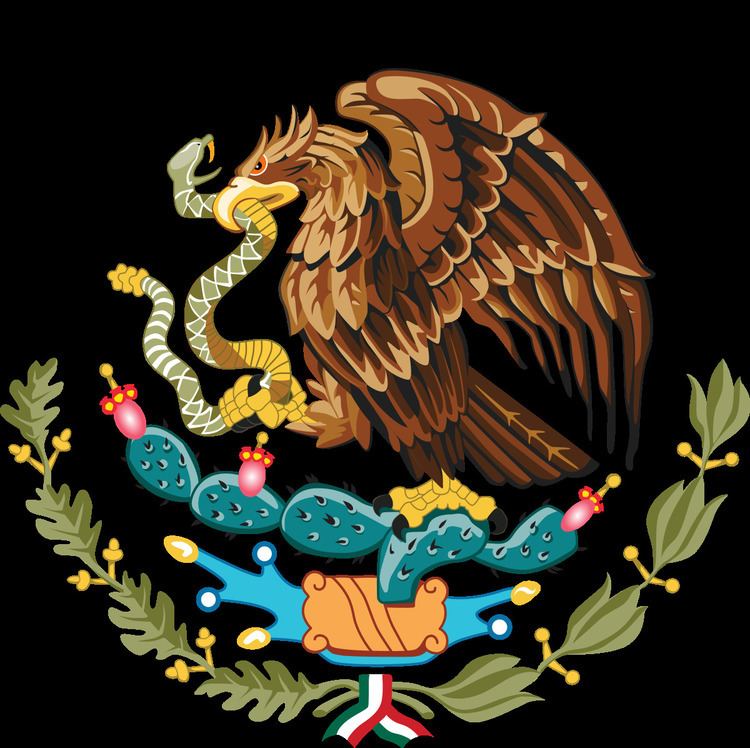Armiger United Mexican States | ||
 | ||
Adopted 16 September 1968(latest version, by Francisco Eppens Helguera) Escutcheon Atop a nopal pedestal, a Mexican golden eagle devouring a rattle snake | ||
The current coat of arms of Mexico (Spanish: Escudo Nacional de México, literally "national shield of Mexico") has been an important symbol of Mexican politics and culture for centuries. The coat of arms depicts a Mexican golden eagle perched on a prickly pear cactus devouring a rattlesnake. To the people of Tenochtitlan this would have strong religious connotations, but to the Europeans, it would come to symbolize the triumph of good over evil (with the snake sometimes representative of the serpent in the Garden of Eden).
Contents
The Seal of the United Mexican States is the seal used by the government of Mexico in any official documents issued by the federal, state or municipal authorities. It is a modified version of the national coat of arms, with the addition of the full official name of the country Estados Unidos Mexicanos, in a semi-circular accommodation in the upper part of the seal. Current and past Mexican peso coinage have had the seal engraved on the obverse of all denominations.The Mexican coat of arms is very important to the people of Mexico.
Legend of Tenochtitlan
The coat of arms recalls the founding of Mexico City, then called Tenochtitlan. The legend of Tenochtitlan as shown in the original Mexica codices, paintings, and post-Cortesian codices, does not include a snake. While the Fejérváry-Mayer codex depicts an eagle attacking a snake, other Mexica illustrations, such as the Codex Mendoza, show only an eagle; in the text of the Ramírez Codex, however, Huitzilopochtli asked the Tenochtitlan people to look for an eagle devouring a snake, perched on an prickly pear cactus. In the text by Chimalpahin Cuauhtlehuanitzin, the eagle is devouring something, but it is not mentioned what it is. Still other versions (such as the backside of the Teocalli of the Sacred War) show the eagle clutching the Aztec symbol of war, the Atl-Tlachinolli glyph, or "burning water".
Moreover, the original meanings of the symbols were different in numerous aspects. The eagle was a representation of the sun god Huitzilopochtli, who was very important, as the Mexicas referred to themselves as the "People of the Sun". The cactus (Opuntia ficus-indica), full of its fruits, called "nochtli" in Nahuatl, represent the island of Tenochtitlan. To the Mexicas, the snake represented wisdom, and it had strong connotations with the god Quetzalcoatl. The story of the snake was derived from an incorrect translation of the Crónica mexicáyotl by Fernando Alvarado Tezozómoc. In the story, the Nahuatl text ihuan cohuatl izomocayan, "the snake hisses", was mistranslated as "the snake is torn". Based on this, Father Diego Durán reinterpreted the legend so that the eagle represents all that is good and right, while the snake represents evil and sin. Despite its inaccuracy, the new legend was adopted because it conformed with European heraldic tradition. To the Europeans it would represent the struggle between good and evil. Although this interpretation does not conform to pre-Columbian traditions, it was an element that could be used by the first missionaries for the purposes of evangelism and the conversion of the native peoples.
Creatures
In 1960, the Mexican ornithologist Rafael Martín del Campo identified the eagle in the pre-Hispanic codex as the northern caracara or "quebrantahuesos", a species common in Mexico (although the name "eagle" is taxonomically incorrect, as the caracara is in the falcon family). The golden eagle is considered the official bird of Mexico. When Father Duran introduced the snake, it was originally an aquatic serpent. But in 1917, the serpent was portrayed as a rattlesnake, because it was more common than the aquatic varieties in pre-Hispanic illustrations. As a result of this, the design and color of the snake on the modern coat of arms do not correspond with those of any species of snake, and were inspired by the representations of Quetzalcoatl, a rattlesnake with quetzal feathers.
